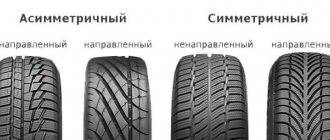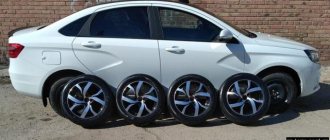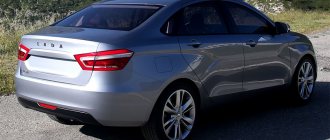- Main overall dimensions and parameters
- Trunk dimensions in centimeters Lada Vesta cross version
- Available useful options for the new body
- Powertrains and transmission
- Trunk capacity
- Equipment of Lada Vesta Classic cars
- Classic/Start
- Comfort
- Comfort/Image
- Comfort/Multimedia
- Luxe/Multimedia
Main overall dimensions and parameters
Lada Vesta is a 4-door spacious sedan, the interior of which is designed for five people. In 2021, the AvtoVAZ concern plans to release a restyled version of the sedan and begin sales of a new body version - the Lada Vesta station wagon.
| Parameter | Unit | Meaning |
| Body length/width/height | mm | 4410/1764/1497 |
| Wheelbase | mm | 2635 |
| Front/rear wheel track | mm | 1510/1510 |
| Clearance | mm | 178 |
| Trunk volume | l | 480 |
| Fuel tank volume | l | 55 |
| Curb weight | kg | 1230 |
| Maximum weight | kg | 1670 |
| Drive unit | Front | |
| Front/rear suspension | Independent/semi-independent with anti-roll bar | |
| Front/rear brakes | Disc/drum |
Having impressive dimensions, the SV and Cross versions have really good luggage compartments. For the first time, a double bottom design is presented here, and the factory abandoned the rear shelf in favor of curtains, which further increased the usable volume.
At the same time, the Lada Vesta Cross model received additional hangers and mesh pockets for small items. However, there are similarities:
- The false floor is retracted, freeing up a spacious niche for additional cargo.
- The side compartments are made with a solid frame, which guarantees the safety of fragile cargo during transportation.
- The useful volume of the luggage compartment is equal for the SV and SV cross models.
- The height and dimensions are identical.
The disadvantages of the car include the poorly thought-out double floor of the luggage compartment. The high threshold formed when the door is opened deepens an additional 15 cm, which complicates the loading of heavy objects. Thus, manipulations have to be carried out exclusively with the step - this imposes additional inconvenience when working with large loads.
The next drawback is the incomplete folding of the seats. The backrests of the structure recline at an angle of 55˚. Therefore, packing long items will be problematic. In some exceptions, buyers complain that after heavy rain or pressure washing, water gets into the trunk of the Lada Vesta.
Such problems are normal for the manufacturer and are considered normal among users. In this case, experts recommend contacting a service center to replace the seals. If the factory service period has expired, the cost of a new rubber band starts from 1000 rubles. In more severe cases, leaks form at the joints of windows.
Thanks to the thoughtful design of the internal parts of the interior panels, engineers were able to fit an impressive trunk into a medium-sized frame. All useful capacity guarantees easy transportation of small furniture or a comfortable trip to the sea or on a camping trip with the whole family. At the same time, there is no shortage of free space.
The standard compartment dimensions are as follows:
- standard volume – 480 l;
- without raised floor – 575 l;
- with seat backs folded - 875 liters.
Clear compartment opening:
- between arched posts – 980 mm;
- maximum width – 1340 mm;
- from the lid to the seat backs – 930 mm;
- maximum length to seat backs – 1820 mm;
- minimum vertical clearance – 660 mm;
- maximum vertical clearance – 830 mm;
- threshold height from the ground – 110 mm;
- raised floor width – 900 mm;
- raised floor length – 940 mm;
- height of additional compartment – 110 mm/with lid – 80 mm;
- capacity of additional niches – 30 l.
Station wagon
Trunk dimensions of the Lada Vesta station wagon:
- 980 mm – width between wheel arches;
- 1340 mm – width with two niches;
- 930 mm – length of the compartment to the back of the rear seat;
- 1820 mm – length to the front seat;
- 660 mm – height above the top of the folded rear seat;
- 830 mm – height above the top of the folded rear seat excluding the cushion;
- 110 mm – threshold height.
In the trunk of the Lada Vesta Cross Station wagon there are niches and nets with which the cargo is secured. In addition, the designers equipped the compartment with a practical organizer; it usually houses various small items necessary for the driver. The organizer drawers stow away to maximize available space, and the spare tire fits easily in the double bottom. The upholstery has hooks on which bags or packages can be hung, and two side lights perfectly illuminate the trunk space for car owners. In addition, there is a 12V socket on the right.
The trunk volume of the Lada Vesta station wagon reaches 480 liters. An additional 95 liters are found in the double bottom. Access to the luggage compartment is provided by a button located on the fifth door.
Trunk dimensions in centimeters Lada Vesta cross version
Trunk measurements in liters are not always clear for understanding the actual dimensions, so they resort to measurements using a tape measure and indicating the values in centimeters. This approach will not leave questions unanswered even for the most inquisitive car enthusiasts. When measuring the luggage compartment of the West Cross with a tape measure, the following values were obtained:
- The depth from the rear row of seats to the plastic trim at the edge is 93 cm.
- The depth from the top of the seats (perpendicular) to the edge of the trunk is 70 cm.
- The depth to the front seats (with the rear row seats folded) is 170 cm.
- The width of the trunk to the wheel arch is 120 cm.
- The width in the wheel arch is 98 cm.
- The opening size is 100 cm.
- The height of the opening is 86 cm.
- The height of the opening from the additional raised floor to the roof of the car (bypassing the curtain) is 70 cm.
In addition to additional niches built into the floor, the cross version of the car also has side niches equipped with nets, hooks and special holding devices for containers with technical fluid.
Comparison with competitors
Vesta's competitors include:
Let us remind you that the trunk volume of a Russian car is 480 liters for both a sedan and a station wagon. In Renault Logan, the volume of this department reaches 510, and in Rio - 500 liters. Solaris will allow you to load only 470 liters of luggage, although both of these models are created on the same platform. The leaders in trunk capacity are the Skoda Rapid and Datsun, which hold 530 liters.
If we compare the features of the luggage compartments, then the Datsuns also have a good and flat floor, and the loading height is optimal. But the arches in Datsuns protrude too much, and the opening width is not enough to load particularly large items.
In this regard, the Solaris trunk causes the most inconvenience: the wheel arches here are the largest, which does not have the best effect on the geometry of the sidewalls. These shortcomings are somewhat concealed due to neat hinges, a flat floor, low loading height and a large opening. Rio, created on the same site as Solaris, has the same advantages and disadvantages, but the usable luggage compartment volume of this car is larger.
Rapid, in addition to the advantages noted by its competitors, has a functional door-lid that, when opened, forms the highest opening for loading. The disadvantage is the threshold height, which is much higher than that of rival models.
Powertrains and transmission
Car power unitToday, Lada Vesta is equipped with two four-cylinder 16-valve gasoline engines:
- the base 1.6-liter power unit has a capacity of 106 “horses”;
- a more powerful 122-horsepower engine of 1.8 liters in volume.
Vehicle performance depends on many factors, including the selected transmission.
| 106 hp, 1.6 l, manual transmission | 106 hp, 1.6 l, robot | 122 hp, 1.8 l, robot | |
| Acceleration 0-100 km/h (s) | 11.2 | 14.1 | 12.1 |
| Maximum speed (km/h) | 175 | 178 | 186 |
| Average fuel consumption per 100 km (l) | 6.9 | 6.6 | 7.2 |
Trunk capacity
The interior space of the Lada Vesta trunk is reduced due to the sloping location of the compartment lid. However, thanks to the impressive parameters of the machine, this drawback is leveled out. The useful volume is 480 liters, regardless of modification. This space is quite enough for a family trip or active recreation.
However, if necessary, the size of the Lada Vesta trunk can be increased to the required criteria. By removing the false floor, an additional 95 l are released. which totals 575 cubic decimeters of space. If that's not enough, the rear seats fold down when loading large structures, freeing up a total of 875 liters of free space, which is comparable to classic SUVs.
At the same time, the length of the flat surface is 170 cm. These indicators are enough for a snowboard, skis or a small refrigerator. At the same time, there is a well-thought-out second luggage compartment shelf. The top compartment allows you to stack a second row of bags on top of the first without risk of damage to the contents. However, the design also has disadvantages.
Sedan
The dimensions of the luggage compartment of the sedan are similar to those of the previous model, and the luggage compartment volume of the Lada Vesta sedan is the same in liters - 480. Working with cargo placed in the car is very convenient: the lid has a large scope, the threshold is quite low. There is also an internal handle to make closing easier. Baskets that are mounted on the roof of the car are popular among drivers. The sedan, like the station wagon, has an absolutely flat floor with a double bottom for the spare tire, and the wheel arches do not protrude, which allows you to place wide loads.
Disadvantages include large hinges that take up a lot of space, and the lack of standard means for securing transported cargo.
The Vesta instruction manual provides reference data on the dimensions of the model and trunk.
Equipment of Lada Vesta cars
The modern Russian sedan Lada Vesta has several trim levels: Luxe, Comfort, Classic. In addition, the standard set of equipment can be supplemented with option packages. The Classic package is equipped with the Start package, the Comfort version has an Image and Multimedia package, and the Luxury version has only Multimedia.
Classic
Classic model The basic configuration has a solid list of options at its disposal:
- airbags for driver and front passenger;
- “child lock” on the rear doors;
- automatic door locking while the car is moving;
- ISOFIX child seat mount;
- immobilizer;
- signaling;
- 3 headrests for second row passengers;
- ERA-GLONASS system;
- ABS is a system that limits brake locking;
- ESC is a system that provides directional stability;
- EBD – braking force distribution;
- HSA – hill start assist;
- TCS – system that prevents wheel slip;
- protection of space under the hood;
- folding backrest of the rear sofa in a ratio of 60/40;
- availability of 12V socket;
- gear shift prompt;
- on-board computer;
- electric power steering;
- adjustable steering column height and reach;
- the presence of seat belt height adjustment;
- central locking with remote control;
- folding key;
- electric drive of front door windows;
- heated first row seats;
- heated and electrically adjustable rear view mirrors;
- additional direction indicators on the exterior mirrors;
- full-size 15” spare wheel on a steel rim;
- 15” steel wheels with decorative caps;
Available useful options for the new body
Despite the rather compact dimensions of the trunk, a domestically produced car will be able to surprise owners with a large range of useful options.
Initially, the model was developed for family people who have basic requirements for comfort and practicality of operation.
However, later the experts diluted the intended purpose of the car and added many stylish details. There are several main options in the new body that will help improve the daily use of the car:
- Folding rear seats. In order to recline the back row, just press a special button. In this case, the folded seats form an almost horizontal, flat plane of the luggage compartment.
- High quality lighting. LADA Vesta SW uses new-style trunk lights that have a directional glow, which has a positive effect on the convenience of unloading or loading the car in the evening.
- Nets for securing cargo. In the luggage compartment of the SV version there are special mesh fasteners. The side panels and rear seat wall have appropriate mounting hardware for installation.
- Spacious underground niches. The luggage compartment design has lower niches with partitions that are hidden behind decorative floor panels. Each compartment is able to accommodate any flat loads in the form of tools or travel accessories.
- Side pockets and niches. Thanks to the presence of additional compartments and closed niches on the side, car enthusiasts can conveniently store cans, jacks and other automotive tools that take up useful space in an ordinary trunk.
The lower half of the trunk space is covered with a special horizontal curtain that stretches its entire length. To increase practicality of operation, the doorway has a plastic finish. The covers protect the bumper seal and paint from mechanical damage during loading.
Recommendations for choosing cases
When choosing, you should take into account the actual operating conditions of the machine, temperature conditions, dust, and gas contamination.
An important factor is the size of the budget. This will determine the initial product category.
The best budget materials for everyday use of a car are jacquard, eco-leather, velor. To highlight the individuality of the interior - genuine leather and its subtypes. If you have any difficulties with the choice, seek advice from tuning studios, workshops, or store managers.
New AvtoVAZ
The new Lada Vesta model in a “universal” body has long been discussed in media sources and on automotive Internet portals. Photos of the Lada Vesta in its new guise presented on websites have caused heated discussions among car enthusiasts. Photos of the interior are very similar to the current interior of the sedan. The similarity in size and appearance is largely due to the fact that the station wagon will be assembled at the same plant in Izhevsk where the sedan is currently being assembled.
Most likely, the new Lada Vesta, like the sedan, will be equipped with three configuration options. What a real station wagon will look like will become known in the near future. The start of sales is scheduled for this fall.
LADA Vesta SW – Technical characteristics – Official LADA website
- Wheel formula / drive...
- Body type / quantity...
- Length / width / height, mm
- Front/rear wheel track,…
- Luggage compartment volume, l
- Engine
- Quantity, location...
- Maximum power, kW (hp) / rev….
- Maximum torque, Nm / rev….
- Dynamic characteristics
- Maximum speed, km/h
- Acceleration time 0-100 km/h, s
- Fuel consumption
- Extra-urban cycle, l/100 km
- Technically permissible maximum weight...
- Maximum trailer weight without brake system /…
- Transmission
- Main gear ratio...
- Suspension
- Steering
- 1.6 l 16 cl. (106 hp), 5MT
- sedan / 4
- 5
- 4410 / 1764 / 1497
- 2635
- 1510 / 1510
- 178
- 480
- 21129
- petrol
- 4, in-line
- 1596
- 78 (106) / 5800
- 148 / 4200
- gasoline 92
- 182
- 11,2
- 9,3
- 5,5
- 6,9
- 1230…1380
- 1670
- 450 / 900
- 55
- 5MT
- 3,9
- 1.8 l 16 cl. (122 hp), 5AMT
- 1.6 l 16 cl. (106 hp), 5AMT
- 1.8 l 16 cl. (122 hp), 5MT
Fuel consumption data is determined under standardized conditions using special measuring equipment, in accordance with the requirements of GOST R41.101–99 (UNECE Rules No. 101). Used to compare cars from different automakers. They are not an operational standard.
- Body
- Wheel formula / drive...
- Body type / quantity...
- Length/width/height by antenna,…
- Front/rear wheel track,…
- Luggage compartment volume in passenger/cargo…
- Engine
- Quantity, location...
- Maximum power, kW (hp) / rev….
- Maximum torque, Nm / rev….
- Dynamic characteristics
- Maximum speed, km/h
- Acceleration time 0-100 km/h, s
- Fuel consumption
- Extra-urban cycle, l/100 km
- Weight
- Technically permissible maximum weight...
- Maximum trailer weight without brake system /…
- Transmission
- Main gear ratio...
- Suspension
- Steering
- Tires
- 1.6 l 16 cl. (106 hp), 5MT
- station wagon / 5
- 5
- 4410 / 1764 / 1508
- 2635
- 1510 / 1510
- 178
- 480 / 825
- 21129
- petrol
- 4, in-line
- 1596
- 78 (106) / 5800
- 148 / 4200
- gasoline 92
- 178
- 12,4
- 9,5
- 5,9
- 7,3
- 1280…1350
- 1730
- 600 / 900
- 55
- 5MT
- 3,9











